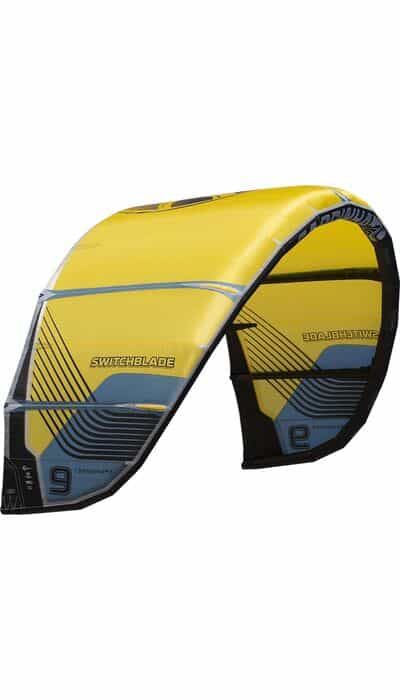| Model |
Switchblade by Cabrinha
|
| Year | 2020 |
| Shape |
Bow-Kite
|
|
Riding Type
|
Freeride |
|
Riding Skill
|
Beginner – Intermediate
|
|
Available sizes
|
14,12,11,10,9,8,7,6,5,4 m²
|
Proven shape, new material: Cabrinha‘s 2020 Switchblade uses a new nano ripstop material to make the kite stiffer and more durable. How much does the upgrade pay?
When kite design legend Pat Goodman moved from Cabrinha to North last year, the 2020 switchblade was already fully designed. How the Switchblade dynasty will continue in the future is not part of this test, because first we just want to know how the kite will fly in the 2020 model year. New in the construction is not the shape of the canopy, but the cloth used.
Cabrinha uses special nano ripstop fabric in the 2020 range. With 55 grams per square meter and a ripstop structure that is three millimeters in size, it is supposed to significantly increase the tensile and tear strength. Cabrinha also wants to improve the stiffness of the canopy and the overall performance. In addition, a new coating will be applied, which will make the canopy feel as good as new even after many hours of flying.
The performance on the water of the 2020 Switchblade
The Switchblade has built a reputation for over a decade as a kite with an extremely robust profile. The 2020 model is no exception. The canopy stands firmly on the edge of the wind window, which is a touch further inside than the competition. This means that the five-strutter has no tendency to front or backstall and flies with stoic composure through gusts and wind holes even in turbulent conditions, without being particularly impressed by them.
If you operate the bar carefully with pointed fingers, the canopy remains calm and does not respond excessively reactive to minimal steering impulses. If you grip a little tighter, even smaller radii are no problem and you can really get the glider moving. When holding and steering the bar, slightly above average forces occur, for which the Switchblade is known.
The steering is not quite as direct as with the Core, but it compares well with stiff Tectanium lines. In general, the distances the bar has to cover when depowering and steering are a bit more generous. This gives the kite an even more stable flight pattern and is especially noticeable when practicing new tricks.
If the launch helper lets go of the tube, you can almost hear the bubbling of a V8 engine in front of his mental ear. With power, there is no need to be stingy with the Switchblade. Similar to a muscle car from the 70s, the steering is also suspended: With sudden, tightly flown directional changes, the kite tends to cut the direct curve path a bit. If you are forced to make sinus curves at the lower wind limit, you should choose larger radii to produce continuous propulsion.
The Switchblade flies far ahead in the top class, which is why it can be attested an excellent low end. The large, linear depower combined with the robust profile offers a lot of control even in high winds. Equipped in this way, the Switchblade has a huge wind range in which it works perfectly. With more pressure in the cloth, a little more lard in the thigh is needed to send the kite to the edge of the wind window using the board edge. When going upwind, this is very gently noticeable, but does not have a negative effect.
If you drop the Switchblade in deep water, you should build up enough counterpressure to turn the kite when relaunching. After that the rest of the relaunch happens almost by itself. The robust flight pattern is helpful in almost all disciplines of kite sports. The Switchblade offers slack for unhooked tricks and even has enough drift for basic maneuvers in small waves. Only on the foil the slight cross pull tendency is a bit more important, moreover you are quickly overpowered with the strong pulling kite if you only have to counter the low friction wing in the water instead of the board edge.
The performance in the vertical can be called up as uncomplicated as ever. The kite is simply flown backwards from a high loading position and then sensitively powered up. You should take care to keep enough tension on the lines and not to send it back fully depowered and then suddenly tear down the bar, but to keep the bar as low as the edge of the board allows.
Here you get the feeling that the kite prefers heavier riders. Once you get the hang of it, you’ll be happy that the Switchblade makes its considerable jump potential available so easily. Neither the timing nor the jump has to be perfectly executed to achieve a decent jump height. In the borderline area, you reach height regions that are only topped by the absolute top riders. However, when it comes to hangtime, no one can fool him and he is at eye level with Rebel and XR.
Conclusion
The model year 2020 offers no bad surprises for friends of Cabrinha kites. The Switchblade has remained a Switchblade. The new cloth suits it well, the characteristics and the handling are well-tried. Fans of the series can access it without hesitation. If you are looking for a kite with a strong basic pull, uncomplicated flight characteristics, a huge wind range and strong all-round characteristics, this is also the right choice. It may not be the most agile kite in the test group, but it is very good-natured and easy to handle.
